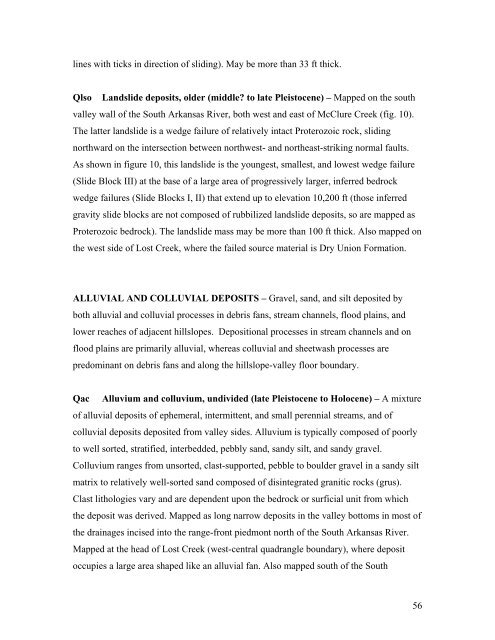Geologic Map of the Maysville Quadrangle, Chaffee County, Colorado
Geologic Map of the Maysville Quadrangle, Chaffee County, Colorado
Geologic Map of the Maysville Quadrangle, Chaffee County, Colorado
Create successful ePaper yourself
Turn your PDF publications into a flip-book with our unique Google optimized e-Paper software.
lines with ticks in direction <strong>of</strong> sliding). May be more than 33 ft thick.<br />
Qlso Landslide deposits, older (middle to late Pleistocene) – <strong>Map</strong>ped on <strong>the</strong> south<br />
valley wall <strong>of</strong> <strong>the</strong> South Arkansas River, both west and east <strong>of</strong> McClure Creek (fig. 10).<br />
The latter landslide is a wedge failure <strong>of</strong> relatively intact Proterozoic rock, sliding<br />
northward on <strong>the</strong> intersection between northwest- and nor<strong>the</strong>ast-striking normal faults.<br />
As shown in figure 10, this landslide is <strong>the</strong> youngest, smallest, and lowest wedge failure<br />
(Slide Block III) at <strong>the</strong> base <strong>of</strong> a large area <strong>of</strong> progressively larger, inferred bedrock<br />
wedge failures (Slide Blocks I, II) that extend up to elevation 10,200 ft (those inferred<br />
gravity slide blocks are not composed <strong>of</strong> rubbilized landslide deposits, so are mapped as<br />
Proterozoic bedrock). The landslide mass may be more than 100 ft thick. Also mapped on<br />
<strong>the</strong> west side <strong>of</strong> Lost Creek, where <strong>the</strong> failed source material is Dry Union Formation.<br />
ALLUVIAL AND COLLUVIAL DEPOSITS – Gravel, sand, and silt deposited by<br />
both alluvial and colluvial processes in debris fans, stream channels, flood plains, and<br />
lower reaches <strong>of</strong> adjacent hillslopes. Depositional processes in stream channels and on<br />
flood plains are primarily alluvial, whereas colluvial and sheetwash processes are<br />
predominant on debris fans and along <strong>the</strong> hillslope-valley floor boundary.<br />
Qac Alluvium and colluvium, undivided (late Pleistocene to Holocene) – A mixture<br />
<strong>of</strong> alluvial deposits <strong>of</strong> ephemeral, intermittent, and small perennial streams, and <strong>of</strong><br />
colluvial deposits deposited from valley sides. Alluvium is typically composed <strong>of</strong> poorly<br />
to well sorted, stratified, interbedded, pebbly sand, sandy silt, and sandy gravel.<br />
Colluvium ranges from unsorted, clast-supported, pebble to boulder gravel in a sandy silt<br />
matrix to relatively well-sorted sand composed <strong>of</strong> disintegrated granitic rocks (grus).<br />
Clast lithologies vary and are dependent upon <strong>the</strong> bedrock or surficial unit from which<br />
<strong>the</strong> deposit was derived. <strong>Map</strong>ped as long narrow deposits in <strong>the</strong> valley bottoms in most <strong>of</strong><br />
<strong>the</strong> drainages incised into <strong>the</strong> range-front piedmont north <strong>of</strong> <strong>the</strong> South Arkansas River.<br />
<strong>Map</strong>ped at <strong>the</strong> head <strong>of</strong> Lost Creek (west-central quadrangle boundary), where deposit<br />
occupies a large area shaped like an alluvial fan. Also mapped south <strong>of</strong> <strong>the</strong> South<br />
56




